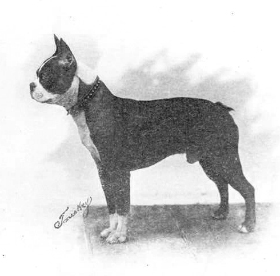Kingway Kennels – Making Boston Terrier History

By Amy Fernandez
Many breeds enjoy enduring popularity, but none have topped the charts more consistently than the Boston Terrier. Recognized in 1893, Bostons ranked first or second from 1905 to 1935. They first gained the top spot in 1915. Airedales claimed it two years later, but Bostons again became AKC’s most popular breed in 1929, holding the position for seven years. Throughout the ‘30s, AKC registered over 10,000 Bostons annually, making it the first breed to reign as top dog for two decades. Although they fell out of the top ten in the ‘60s, over a third of AKC-registered Bostons were shown. They consistently earned one of the highest ratios of AKC championships.
When they first came on the scene, most fanciers viewed the breed as a local New England fad. As James Watson explained in The Dog Book, “these dogs were not called Boston Terriers, but were first lumped in with Bull Terriers…finally the numbers increased and the wishes for opportunities to exhibit more frequently expressed… shortly after show committees began offering designated classes for them the Bostonians got together and formed a club in 1891.” The Boston’s phenomenal success is traceable to unprecedented support from every sector of the fancy – breeders, exhibitors and pet lovers throughout the country. They had clout.

Their initial petition for AKC recognition didn’t exactly get a warm welcome from the studbook committee…which Watson then headed. After numerous applications, vehement objections from bulldog and bull terrier fanciers, and ostensible misgivings of the studbook committee, AKC relented and accepted the Boston Terrier in 1893. By then, the dog world should have realized they were dealing with an exceptionally persistent, determined group. Boston fanciers were resolute individualists, accustomed to bucking the system and doing things their way.
And Kingway kennel was a perfect example of that maverick spirit. The Rockies didn’t seem like an ideal location for a major show kennel, but Mrs. W.E. Porter made it happen. She started in the dog game showing St. Bernards and acquired her first Boston in 1906. When James Mortimer awarded his first blue ribbon, she was hooked for life. She registered her Kingway prefix in 1911 and proceeded to build a breathtaking kennel facility on the outskirts of Denver. Even today, century old photos reveal its magnificent design and craftsmanship.
The 60 x 20 main kennel included a full kitchen and grooming room. It housed 15-35 adults. Each had a three foot wide pen, two foot tall raised sleeping box, and an eight foot long outdoor run. A second building for brood bitches and puppies was equipped with enormous double pane windows and glass-enclosed runs. New stock and all Kingway Bostons returning from shows were isolated in an equally large quarantine kennel for observation. All three buildings were temperature controlled and double insulted, each with its own heating and cooling system. The Bostons were snug and warm, but Mrs. Porter customarily decamped to her California residence during Colorado winters.
She also imported Massachussets breed expert B.F. Liberty who helped design this fabulous kennel and supervise its construction. Along with running the operation, he did the handling. Back then, few dog clubs existed out west and most of the 90-100 all breed shows were concentrated on the east coast. But specialties filled out Kingway’s calendar. Boston clubs sprang up like weeds throughout the country. Entries typically exceeded 100, occasionally topping 500. It was the keenest competition the breed would ever encounter. That became a key factor in its success, because as Watson noted in 1893, it barely qualified as a stable breed when it entered the AKC studbook.
Kingway’s show territory typically spanned Texas, Oklahoma, Wisconsin, Minnesota, Nebraska, and Iowa, with occasional forays to major circuits in the south, east, and California. The closest shows were at least a two day drive and Kingway dogs traveled over 10,000 miles annually at a time when long distance drives featured dodgy roads, frequent breakdowns, and DIY repairs, along with the complications of transporting a breed that is sensitive to both heat and cold.
Kingway met the challenge. Within a decade, they dominated the competition from coast to coast. Porter assembled her breeding program from the finest stock. Her foundation stud, Ch. Mosholu Blink, ranks among the breed’s greatest sires. Whelped in 1917, he descended from the bedrock of Boston quality. Owned and campaigned by Mosholu kennel in the Bronx, he retired Westminster’s huge sterling silver Win Sum Challenge Cup for best Non-Sporting dog and get after winning consecutively from 1924–26. Kingway’s stud force also included his sons Ch. Mosholu Buddie Blink and Ch. Kingway Blink.
Along with building a rock solid kennel and bloodline, Porter also had the foresight to mentor a protégé. Leonard Myers fell in love with Bostons at age five and bred his first litter in 1935. After WWII he studied at the University of Colorado on the GI Bill and, with Mrs. Porter’s guidance, founded his Silver Dollar kennel. Its winners included Ch. Silver’s Fancy Chap, owner/handled to BIS from the BBE class under Vincent Perry in 1952. After Porter’s death, he took over the Kingway prefix and continued the bloodline until 1971 when a massive fire wiped out 14 generations of carefully crafted breeding.
His multifaceted contributions to the breed also included serving as an officer of the national club and writing the AKC Gazette breed column. He was first approved to judge in 1960. In 2003 he judged the Boston Terrier Club of America National Specialty for the fifth time. That year, Bostons ranked 18th among AKC breeds. A decade later, it stands 23rd, not bad at all for a breed that AKC was notably reluctant to admit it to the studbook.
Short URL: http://caninechronicle.com/?p=45060
Comments are closed











